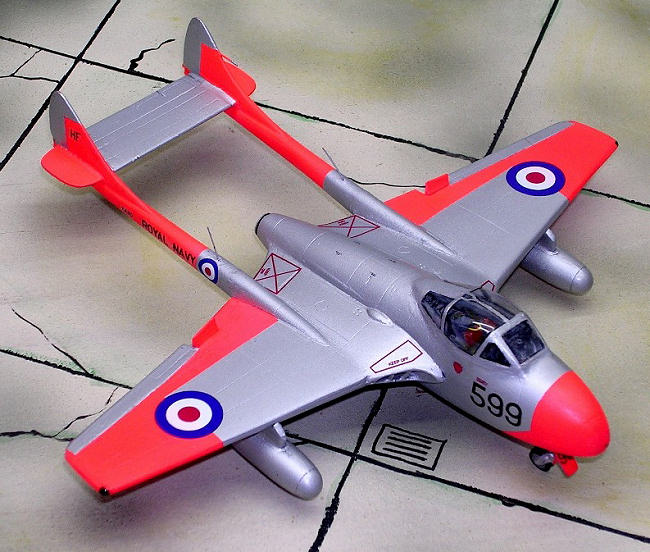
CMR 1/72 Sea Vampire
| KIT #: | ? |
| PRICE: | $? |
| DECALS: | Two options? |
| REVIEWER: | Carmel J. Attard |
| NOTES: | Resin |

| HISTORY |
Emerging from the prototypes that
were tested during the war years, the Vampire entered RAF service in March 1946.
The box shaped unique design did not make it a sparkling performer but one that
could be adoptable for many roles and it was an aircraft
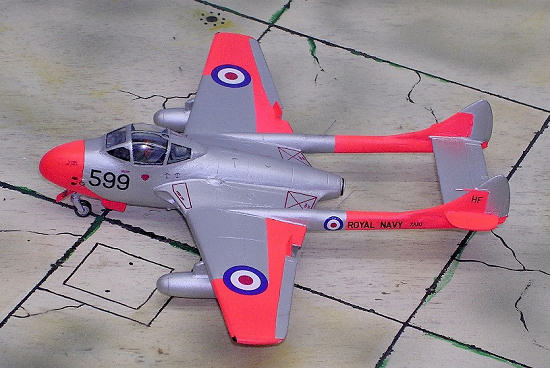 much liked by those who flew
it. In the late 40s the two-seat Vampires emerged. This was the T11 and the
Royal Navy was so much impressed with it that an order for 73 was made. This had
minor modifications and the type was known as the T-22 Sea Vampire. Unlike the
single seat Sea Vampire this was a shore-based aircraft and several were based
at Hal Far in Malta over the years besides other naval shore bases in the UK.
The delivery being made between 1952-55. The T-22 Sea Vampire continued to
improve over the years so that the late production incorporated a 1 piece hood
as well as ejection seats. Earlier T-22s had these modifications retrofitted.
The Royal Navy continued to use the T-22 into the early 60s and examples of
these were seen at Ta’ Qali, Luqa and Hal Far airfields in Malta. At first these
carried the silver and yellow bands colour scheme on wings and tail-booms but in
the later years the aluminum and Day-Glow orange was very prominent on local
T-22s. An example of the T-22 Sea Vampire is represented at the Ta’Qali Aviation
Museum which is a perfect restored aircraft finished in the RN markings when
based at Hal-Far airfield.
much liked by those who flew
it. In the late 40s the two-seat Vampires emerged. This was the T11 and the
Royal Navy was so much impressed with it that an order for 73 was made. This had
minor modifications and the type was known as the T-22 Sea Vampire. Unlike the
single seat Sea Vampire this was a shore-based aircraft and several were based
at Hal Far in Malta over the years besides other naval shore bases in the UK.
The delivery being made between 1952-55. The T-22 Sea Vampire continued to
improve over the years so that the late production incorporated a 1 piece hood
as well as ejection seats. Earlier T-22s had these modifications retrofitted.
The Royal Navy continued to use the T-22 into the early 60s and examples of
these were seen at Ta’ Qali, Luqa and Hal Far airfields in Malta. At first these
carried the silver and yellow bands colour scheme on wings and tail-booms but in
the later years the aluminum and Day-Glow orange was very prominent on local
T-22s. An example of the T-22 Sea Vampire is represented at the Ta’Qali Aviation
Museum which is a perfect restored aircraft finished in the RN markings when
based at Hal-Far airfield.
| THE KIT |
 CMR
are once more presenting another resin kit, this time a T-22 Sea Vampire that is
contained in sealed plastic bags. The kit consists of 54 light tan coloured
resin and there are two vac-form canopies one being spare. The kit also comes wi
CMR
are once more presenting another resin kit, this time a T-22 Sea Vampire that is
contained in sealed plastic bags. The kit consists of 54 light tan coloured
resin and there are two vac-form canopies one being spare. The kit also comes wi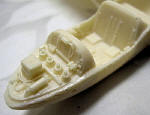 th
seven A-4 sized sheets of scale drawings and instruction, which carry no less
than five different colour schemes. All in all CMR has tackled the production of
the kit quite effectively. The lower half of the kit along with the wings comes
in one piece. This includes a detailed front and rear bulkheads, cockpit floor
and detailed sidewalls. There is also a detailed nose electronic bay and detail
in the nose wheel well and interior of flaps if left in the lowered flap
position.
th
seven A-4 sized sheets of scale drawings and instruction, which carry no less
than five different colour schemes. All in all CMR has tackled the production of
the kit quite effectively. The lower half of the kit along with the wings comes
in one piece. This includes a detailed front and rear bulkheads, cockpit floor
and detailed sidewalls. There is also a detailed nose electronic bay and detail
in the nose wheel well and interior of flaps if left in the lowered flap
position.
It is
assumed that all the solid resin material content placed ahead of the main
wheels should in the end render the model not a tail sitter. The upper nose
cover with all the ribbing interior detail comes in one piece with the rest of
the fuselage. There is however a recess in the inside of the casting that shows
the parting way and simplifies cutting in the event that
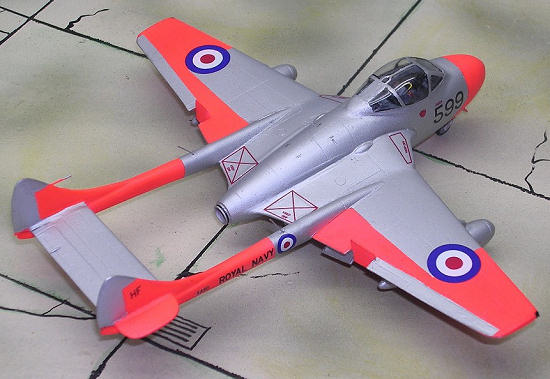 you wish to leave the
electronic bay open. There is options of flaps for an ‘up or down’ position and
the speed brakes can be left open or closed. Two 100-imp gallons under wing
tanks are supplied if it is decided to fix them on. Reference is made to the
oblique drawings supplied in order to establish the exact position where the
tanks are to be fixed. The position of the under wing antenna is wrongly
indicated in the front view on Page 2 and is correctly shown on oblique drawing
on Page 3. One other observation is that the inner flaps, the set closer to the
fuselage are not quite shaped to conform to the opening that they are intended
to fit, and these were shaped to the matching size with a flat file.
you wish to leave the
electronic bay open. There is options of flaps for an ‘up or down’ position and
the speed brakes can be left open or closed. Two 100-imp gallons under wing
tanks are supplied if it is decided to fix them on. Reference is made to the
oblique drawings supplied in order to establish the exact position where the
tanks are to be fixed. The position of the under wing antenna is wrongly
indicated in the front view on Page 2 and is correctly shown on oblique drawing
on Page 3. One other observation is that the inner flaps, the set closer to the
fuselage are not quite shaped to conform to the opening that they are intended
to fit, and these were shaped to the matching size with a flat file.
| CONSTRUCTION |
| COLORS & MARKINGS |
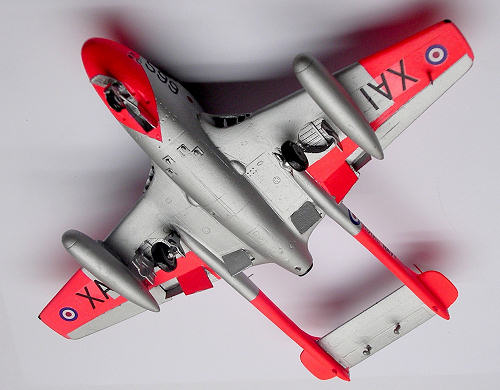 This happened to be my second
occasion of building the 2-seat T-22, my first being an Airmodel conversion
vacform kit which I merged with a frog Vampire kit parts as directed in the
instruction. My first example was in silver and yellow bands scheme, like the
type I spotted in 1991 at Duxford, UK. The CMR model will
therefore be in the alternative trainer scheme of silver and day-glow orange.
This happened to be my second
occasion of building the 2-seat T-22, my first being an Airmodel conversion
vacform kit which I merged with a frog Vampire kit parts as directed in the
instruction. My first example was in silver and yellow bands scheme, like the
type I spotted in 1991 at Duxford, UK. The CMR model will
therefore be in the alternative trainer scheme of silver and day-glow orange.
 There
are two markings supplied and for obvious reasons I chose to make mine as a
Hal-Far based 750 Sqd Royal Navy that operated circa 1965. This also happened to
be the markings and finish scheme of the T-22 at the Ta’Qali Malta Aviation
Museum. Other colour options included with the CMR model are one from 727 Sqd at
Brawdy (1963), another one in Day-Glo scheme based at Lossiemouth (1962), a
grayish blue and white admiral barge from Station Flight at
There
are two markings supplied and for obvious reasons I chose to make mine as a
Hal-Far based 750 Sqd Royal Navy that operated circa 1965. This also happened to
be the markings and finish scheme of the T-22 at the Ta’Qali Malta Aviation
Museum. Other colour options included with the CMR model are one from 727 Sqd at
Brawdy (1963), another one in Day-Glo scheme based at Lossiemouth (1962), a
grayish blue and white admiral barge from Station Flight at
 Yeovilton
1967 and another admiral Barge in emerald Gren upper and white lower from
Lee-on-Solent in 1963. The decal sheet is perfectly registered and also includes
all the stencil notes that decorate the Sea Vampire. On the negative side there
was a tiny area with localized porosity on the upper fuselage, which showed out
only when I applied the pre-coat light paint. This was easily attended to with a
little putty followed by sanding down.
Yeovilton
1967 and another admiral Barge in emerald Gren upper and white lower from
Lee-on-Solent in 1963. The decal sheet is perfectly registered and also includes
all the stencil notes that decorate the Sea Vampire. On the negative side there
was a tiny area with localized porosity on the upper fuselage, which showed out
only when I applied the pre-coat light paint. This was easily attended to with a
little putty followed by sanding down.| CONCLUSIONS |
 Having built the 4th
kit in a line of Vampires, the CMR kit definitely turns out to be the winner in
view of fine detail and in way of accuracy in shape as well as provision of
choice of markings. It took some effort to handle the tiny parts but the end
result is very pleasing and definitely recommends the kit without reservations.
Thanks to Roger who provided the kit for the review.
Having built the 4th
kit in a line of Vampires, the CMR kit definitely turns out to be the winner in
view of fine detail and in way of accuracy in shape as well as provision of
choice of markings. It took some effort to handle the tiny parts but the end
result is very pleasing and definitely recommends the kit without reservations.
Thanks to Roger who provided the kit for the review.
October 2006
Copyright ModelingMadness.com
If you would like your product reviewed fairly and fairly quickly, please contact the editor or see other details in the Note to Contributors.